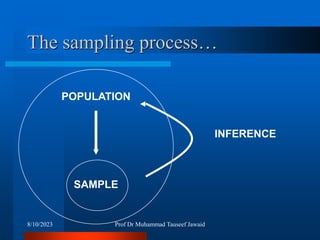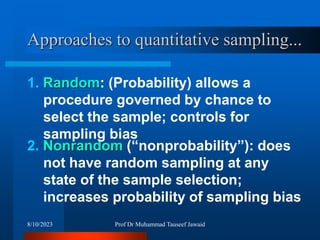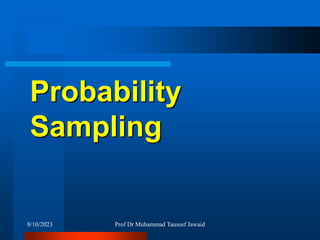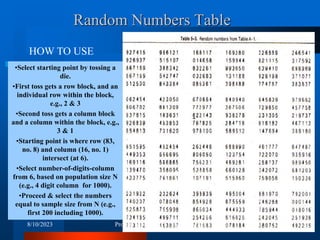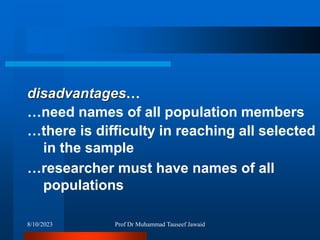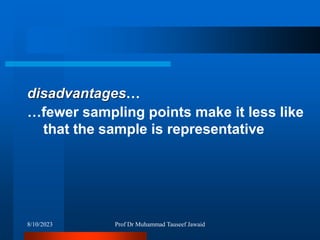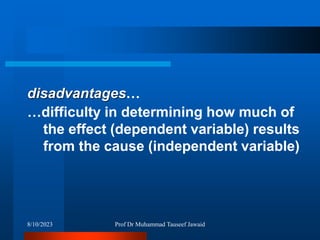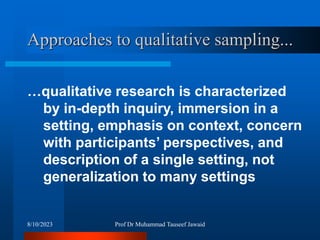Lecture Sampling Methods by Prof: Dr Tauseef Jawaid.ppt
- 1. MBBS.USMLE, DPH, Dip-Card, M.Phil, FCPS Professor Community Medicine Gujranwala Medical College Gujranwala Ex-Professor Community Medicine UmulQurrah University Makka/King Khalid University Saudi Arabia
- 3. The Scientific Method 1. Develop the problem 2. Develop a theoretical solution to the problem 3. Formulate the hypothesis or question 4. Formulate the research plan (methods) 5. Collect and analyze the data 6. Interpret the results and form conclusions 7. Refine the theory 8/10/2023 Prof Dr Muhammad Tauseef Jawaid
- 4. Formulation of the Research Methods A. Selecting the Appropriate Design B. Selecting the Subjects C. Selecting Measurement Methods & Techniques D. Selecting Instrumentation 8/10/2023 Prof Dr Muhammad Tauseef Jawaid
- 5. Formulation of the Research Methods E. Developing Procedures & Protocol F. Using a Pilot Study G. Selecting the Appropriate Analysis Techniques H. Developing a Timeline & Budget I. Collecting the Data 8/10/2023 Prof Dr Muhammad Tauseef Jawaid
- 6. OBJECTIVES Identify and define the population(s) to be studied. Identify and describe common methods of sampling. Discuss problems of bias that should be avoided when selecting a sample. List the issues to consider when deciding on sample size. Decide on the sampling method(s) and sample size(s) most appropriate for the research design you are developing. 8/10/2023 Prof Dr Muhammad Tauseef Jawaid
- 7. Sampling… The process of selecting a number of individuals for a study in such a way that the individuals represent the larger group from which they were selected 8/10/2023 Prof Dr Muhammad Tauseef Jawaid
- 8. 14-8 Why Sample? Greater accuracy Availability of elements Greater speed Sampling provides Lower cost 8/10/2023 Prof Dr Muhammad Tauseef Jawaid
- 9. 14-9 When Is a Census Appropriate? Necessary Feasible 8/10/2023 Prof Dr Muhammad Tauseef Jawaid
- 10. 14-10 What Is a Valid Sample? Accurate Precise 8/10/2023 Prof Dr Muhammad Tauseef Jawaid
- 11. Sample… …the representatives selected for a study whose characteristics exemplify the larger group from which they were selected 8/10/2023 Prof Dr Muhammad Tauseef Jawaid
- 12. Population… …the larger group from which individuals are selected to participate in a study 8/10/2023 Prof Dr Muhammad Tauseef Jawaid
- 13. The purpose for sampling… To gather data about the population in order to make an inference that can be generalized to the population 8/10/2023 Prof Dr Muhammad Tauseef Jawaid
- 14. The sampling process… POPULATION SAMPLE INFERENCE 8/10/2023 Prof Dr Muhammad Tauseef Jawaid
- 15. Regarding the sample… POPULATION (N) SAMPLE (n) IS THE SAMPLE REPRESENTATIVE? 8/10/2023 Prof Dr Muhammad Tauseef Jawaid
- 16. Regarding the inference… POPULATION (N) SAMPLE (n) INFERENCE IS THE INFERENCE GENERALIZABLE? 8/10/2023 Prof Dr Muhammad Tauseef Jawaid
- 17. 14-17 Sampling Design within the Research Process 8/10/2023 Prof Dr Muhammad Tauseef Jawaid
- 18. Mistakes to be conscious of... 2. Sampling bias …which threaten to render a study’s findings invalid 1. Sampling error 8/10/2023 Prof Dr Muhammad Tauseef Jawaid
- 19. Sampling error… …the chance and random variation in variables that occurs when any sample is selected from the population …sampling error is to be expected 8/10/2023 Prof Dr Muhammad Tauseef Jawaid
- 20. …to avoid sampling error, a census of the entire population must be taken …to control for sampling error, researchers use various sampling methods 8/10/2023 Prof Dr Muhammad Tauseef Jawaid
- 21. Sampling bias… …nonrandom differences, generally the fault of the researcher, which cause the sample is over-represent individuals or groups within the population and which lead to invalid findings …sources of sampling bias include the use of volunteers and available groups 8/10/2023 Prof Dr Muhammad Tauseef Jawaid
- 22. Steps in sampling... 2. Determine sample size (n) 3. Control for bias and error 4. Select sample 1. Define population (N) to be sampled 8/10/2023 Prof Dr Muhammad Tauseef Jawaid
- 23. 1. Define population to be sampled... Identify the group of interest and its characteristics to which the findings of the study will be generalized …called the “target” population (the ideal selection) …oftentimes the “accessible” or “available” population must be used (the realistic selection) 8/10/2023 Prof Dr Muhammad Tauseef Jawaid
- 24. 2. Determine the sample size... The size of the sample influences both the representativeness of the sample and the statistical analysis of the data …larger samples are more likely to detect a difference between different groups …smaller samples are more likely not to be representative 8/10/2023 Prof Dr Muhammad Tauseef Jawaid
- 25. Rules of thumb for determining the sample size... 2. For smaller samples (N ‹ 100), there is little point in sampling. Survey the entire population. 1. The larger the population size, the smaller the percentage of the population required to get a representative sample 8/10/2023 Prof Dr Muhammad Tauseef Jawaid
- 26. 4. If the population size is around 1500, 20% should be sampled. 3. If the population size is around 500 (give or take 100), 50% should be sampled. 5. Beyond a certain point (N = 5000), the population size is almost irrelevant and a sample size of 400 may be adequate. 8/10/2023 Prof Dr Muhammad Tauseef Jawaid
- 27. 3. Control for sampling bias and error... Be aware of the sources of sampling bias and identify how to avoid it Decide whether the bias is so severe that the results of the study will be seriously affected In the final report, document awareness of bias, rationale for proceeding, and potential effects 8/10/2023 Prof Dr Muhammad Tauseef Jawaid
- 28. 4. Select the sample... A process by which the researcher attempts to ensure that the sample is representative of the population from which it is to be selected …requires identifying the sampling method that will be used 8/10/2023 Prof Dr Muhammad Tauseef Jawaid
- 29. Approaches to quantitative sampling... 2. Nonrandom (“nonprobability”): does not have random sampling at any state of the sample selection; increases probability of sampling bias 1. Random: (Probability) allows a procedure governed by chance to select the sample; controls for sampling bias 8/10/2023 Prof Dr Muhammad Tauseef Jawaid
- 30. 14-30 Types of Sampling Designs Element Selection Probability Nonprobability Unrestricted Simple random Convenience Restricted Complex random Purposive Systematic Judgment Cluster Quota Stratified Snowball Double 8/10/2023 Prof Dr Muhammad Tauseef Jawaid
- 31. Types of Sampling Methods Quota Sampling Non-Probability Samples Convenience Snow ball Probability Samples Simple Random Systematic Stratified Cluster Purposive 8/10/2023 Prof Dr Muhammad Tauseef Jawaid
- 32. Probability Sampling 8/10/2023 Prof Dr Muhammad Tauseef Jawaid
- 33. Probability Sampling This is one in which each person in the population has a chance/probability of being selected Probability Sample Simple Random Systematic Stratified Cluster 8/10/2023 Prof Dr Muhammad Tauseef Jawaid
- 34. 14-34 Steps in Sampling Design What is the target population? What are the parameters of interest? What is the sampling frame? What is the appropriate sampling method? What size sample is needed? 8/10/2023 Prof Dr Muhammad Tauseef Jawaid
- 35. Random sampling strategies to collect quantitative data If the aim of a study is to measure variables distributed in a population (e.g., diseases) or to test hypotheses about which factors are contributing significantly to a certain problem, we have to be sure that we can generalize the findings obtained from a sample to the total study population. Then, purposeful sampling methods are inadequate, and probability- or random sampling methods have to be used. 8/10/2023 Prof Dr Muhammad Tauseef Jawaid
- 36. Random sampling methods... 2. Stratified sampling 3. Cluster sampling 4. Systematic sampling 1. Simple random sampling 8/10/2023 Prof Dr Muhammad Tauseef Jawaid
- 37. PROBABILITY SAMPLING involves using random selection procedures to ensure that each unit of the sample is chosen on the basis of chance. All units of the study population should have an equal, or at least a known chance of being included in the sample. Probability sampling requires that a listing of all study units exists or can be compiled. This listing is called the sampling frame. 8/10/2023 Prof Dr Muhammad Tauseef Jawaid
- 38. Types of probability sampling methods Simple random sampling Systematic sampling Stratified sampling Cluster sampling Multistage sampling 8/10/2023 Prof Dr Muhammad Tauseef Jawaid
- 39. Simple Random Samples Every individual or item from the frame has an equal chance of being selected Selection may be with replacement or, without replacement Samples obtained from table of random numbers or computer random number generators Random samples are unbiased and, on average, representative of the population 8/10/2023 Prof Dr Muhammad Tauseef Jawaid
- 40. 1. Simple random sampling: the process of selecting a sample that allows individual in the defined population to have an equal and independent chance of being selected for the sample 8/10/2023 Prof Dr Muhammad Tauseef Jawaid
- 41. Steps in random sampling... 2. Determine the desired sample size. 3. List all members of the population. 4. Assign all individuals on the list a consecutive number from zero to the required number. Each individual must have the same number of digits as each other individual. 1. Identify and define the population. 8/10/2023 Prof Dr Muhammad Tauseef Jawaid
- 42. 6. For the selected number, look only at the number of digits assigned to each population member. 5. Select an arbitrary number in the table of random numbers. 8/10/2023 Prof Dr Muhammad Tauseef Jawaid
- 43. 8. Go to the next number in the column and repeat step #7 until the desired number of individuals has been selected for the sample. 7. If the number corresponds to the number assigned to any of the individuals in the population, then that individual is included in the sample. 8/10/2023 Prof Dr Muhammad Tauseef Jawaid
- 44. Simple Random Sampling In this method, all elements may have an equal chance of being selected in the sample: – Lottery Method • Small sample sizes, with numbers of population written on pieces of papers, drawn from a basket without looking. • With and Without Replacement. – Random Numbers Table – Computer Generated Random Sample 8/10/2023 Prof Dr Muhammad Tauseef Jawaid
- 45. Random Numbers Table •Select starting point by tossing a die. •First toss gets a row block, and an individual row within the block, e.g., 2 & 3 •Second toss gets a column block and a column within the block, e.g., 3 & 1 •Starting point is where row (83, no. 8) and column (16, no. 1) intersect (at 6). •Select number-of-digits-column from 6, based on population size N (e.g., 4 digit column for 1000). •Proceed & select the numbers equal to sample size from N (e.g., first 200 including 1000). HOW TO USE 8/10/2023 Prof Dr Muhammad Tauseef Jawaid
- 46. advantages… …easy to conduct …strategy requires minimum knowledge of the population to be sampled 8/10/2023 Prof Dr Muhammad Tauseef Jawaid
- 47. disadvantages… …need names of all population members …may over- represent or under- estimate sample members …there is difficulty in reaching all selected in the sample 8/10/2023 Prof Dr Muhammad Tauseef Jawaid
- 48. 14-48 Simple Random Advantages Easy to implement with random dialing Disadvantages Requires list of population elements Time consuming Uses larger sample sizes Produces larger errors High cost 8/10/2023 Prof Dr Muhammad Tauseef Jawaid
- 49. Systematic Random Sampling Here, after knowing the population size (N), a sampling interval is made (every Kth), depending on the required sample size (population / Kth interval) (1000 / 5 = 200). If sample size is known, then calculate Kth interval (Population / Sample size = Kth interval) (1000 / 200 = 5). The first sample number is selected from the Kth interval by simple random sampling (numbers 1 – 5 included). Thereafter every Kth person is included in the sample till the population limit. Useful for hospital-based studies. 8/10/2023 Prof Dr Muhammad Tauseef Jawaid
- 50. Systematic sample This method is referred to as a systematic sample with a random start. This is done by picking every 5th or 10th unit at regular intervals. For example to carry out a Malria survey in a town, we take 10% sample. If the total population of the town is about 5000. The sample comes to 500. 8/10/2023 Prof Dr Muhammad Tauseef Jawaid
- 51. Randomly select one individual from the 1st group Select every k-th individual thereafter We number the houses first. Then a number is taken at random; say 3.Than every 10th number is selected from that point onward like 3, 13, 23, 33 etc. Systematic Samples N = 500 n = 3 k = 10 First Group 8/10/2023 Prof Dr Muhammad Tauseef Jawaid
- 52. 4. Systematic sampling: the process of selecting individuals within the defined population from a list by taking every Kth name. 8/10/2023 Prof Dr Muhammad Tauseef Jawaid
- 53. Steps in systematic sampling... 2. Determine the desired sample size. 3. Obtain a list of the population. 4. Determine what K is equal to by dividing the size of the population by the desired sample size. 1. Identify and define the population. 8/10/2023 Prof Dr Muhammad Tauseef Jawaid
- 54. 6. Starting at that point, take every Kth name on the list until the desired sample size is reached. 5. Start at some random place in the population list. Close you eyes and point your finger to a name. 7. If the end of the list is reached before the desired sample is reached, go back to the top of the list. 8/10/2023 Prof Dr Muhammad Tauseef Jawaid
- 55. advantages… …sample selection is simple 8/10/2023 Prof Dr Muhammad Tauseef Jawaid
- 56. disadvantages… …all members of the population do not have an equal chance of being selected …the Kth person may be related to a periodical order in the population list, producing unrepresentativeness in the sample 8/10/2023 Prof Dr Muhammad Tauseef Jawaid
- 57. 14-57 Systematic Advantages Simple to design Easier than simple random Easy to determine sampling distribution of mean or proportion Disadvantages Periodicity within population may skew sample and results Trends in list may bias results Moderate cost 8/10/2023 Prof Dr Muhammad Tauseef Jawaid
- 58. 2. Stratified sampling: the process of selecting a sample that allows identified subgroups in the defined population to be represented in the same proportion that they exist in the population 8/10/2023 Prof Dr Muhammad Tauseef Jawaid
- 59. Stratified Random Sampling The population is first divided into well- defined (non-overlapping) strata, so that strata are heterogeneous, but elements are homogeneous within each stratum, e.g., S- E. status, mild, moderate, severe dysplasia, etc. The elements in each stratum are then randomly sampled by either simple or systematic sampling methods. Sample size for each stratum is determined based on study requirements. Useful for ordinal level sampling. 8/10/2023 Prof Dr Muhammad Tauseef Jawaid
- 60. Stratified Samples Procedure: Divide the population into strata (mutually exclusive classes), such as men and women. Then randomly sample within strata. Suppose a population is 30% male and 70% female. To get a sample of 100 people, we randomly choose males (from the population of all males) and, separately, choose females. Our sample is then guaranteed to have exactly the correct proportion of sexes. 8/10/2023 Prof Dr Muhammad Tauseef Jawaid
- 61. Steps in stratified sampling... 2. Determine the desired sample size. 3. Identify the variable and subgroups (strata) for which you want to guarantee appropriate, equal representation. 1. Identify and define the population. 8/10/2023 Prof Dr Muhammad Tauseef Jawaid
- 62. 5. Randomly select, using a table of random numbers) an “appropriate” number of individuals from each of the subgroups, appropriate meaning an equal number of individuals 4. Classify all members of the population as members of one identified subgroup. 8/10/2023 Prof Dr Muhammad Tauseef Jawaid
- 63. advantages… …more precise sample …can be used for both proportions and stratification sampling …sample represents the desired strata 8/10/2023 Prof Dr Muhammad Tauseef Jawaid
- 64. disadvantages… …need names of all population members …there is difficulty in reaching all selected in the sample …researcher must have names of all populations 8/10/2023 Prof Dr Muhammad Tauseef Jawaid
- 65. 14-65 Stratified Advantages Control of sample size in strata Increased statistical efficiency Provides data to represent and analyze subgroups Enables use of different methods in strata Disadvantages Increased error will result if subgroups are selected at different rates Especially expensive if strata on population must be created High cost 8/10/2023 Prof Dr Muhammad Tauseef Jawaid
- 66. 3. Cluster sampling: the process of randomly selecting intact groups, not individuals, within the defined population sharing similar characteristics 8/10/2023 Prof Dr Muhammad Tauseef Jawaid
- 67. Cluster Random Sampling The population is divided into clusters, which are homogeneous, but the elements within the clusters are heterogeneous, e.g., Provinces, Districts, Streets, Wards, etc. Sampling is done randomly (simple / systematic): – Of the clusters, then including all elements as part of sample (if clusters are too many but elements are few). – Of the elements (if clusters are few, but elements in clusters are too large). Ideal for surveys – community, hospital based, etc. 8/10/2023 Prof Dr Muhammad Tauseef Jawaid
- 68. Cluster Samples Population divided into several “clusters,” each representative of the population Simple random sample selected from each The samples are combined into one Population divided into 4 clusters. 8/10/2023 Prof Dr Muhammad Tauseef Jawaid
- 69. Steps in cluster sampling... 2. Determine the desired sample size. 3. Identify and define a logical cluster. 4. List all clusters (or obtain a list) that make up the population of clusters. 1. Identify and define the population. 5. Estimate the average number of population members per cluster. 8/10/2023 Prof Dr Muhammad Tauseef Jawaid
- 70. 7. Randomly select the needed number of clusters by using a table of random numbers. 6. Determine the number of clusters needed by dividing the sample size by the estimated size of a cluster. 8. Include in your study all population members in each selected cluster. 8/10/2023 Prof Dr Muhammad Tauseef Jawaid
- 71. advantages… …efficient …researcher doesn’t need names of all population members …reduces travel to site …useful for educational research 8/10/2023 Prof Dr Muhammad Tauseef Jawaid
- 72. disadvantages… …fewer sampling points make it less like that the sample is representative 8/10/2023 Prof Dr Muhammad Tauseef Jawaid
- 73. 14-73 Cluster Advantages Provides an unbiased estimate of population parameters if properly done Economically more efficient than simple random Lowest cost per sample Easy to do without list Disadvantages Often lower statistical efficiency due to subgroups being homogeneous rather than heterogeneous Moderate cost 8/10/2023 Prof Dr Muhammad Tauseef Jawaid
- 74. 14-74 Stratified and Cluster Sampling Stratified Population divided into few subgroups Homogeneity within subgroups Heterogeneity between subgroups Choice of elements from within each subgroup Cluster Population divided into many subgroups Heterogeneity within subgroups Homogeneity between subgroups Random choice of subgroups 8/10/2023 Prof Dr Muhammad Tauseef Jawaid
- 75. Multi - Stage Random Sampling If sampling is to be done in multiple stages, e.g., District Tehsil Village Households, then each level is randomly sampled, usually by systematic random method. Useful for surveys with large sample sizes, e.g., national surveys, provincial surveys, etc. 8/10/2023 Prof Dr Muhammad Tauseef Jawaid
- 76. Non Probability Sampling 8/10/2023 Prof Dr Muhammad Tauseef Jawaid
- 77. 14-77 Nonprobability Samples Cost Feasibility Time No need to generalize Limited objectives 8/10/2023 Prof Dr Muhammad Tauseef Jawaid
- 78. 14-78 Nonprobability Sampling Methods Convenience Judgment Quota Snowball 8/10/2023 Prof Dr Muhammad Tauseef Jawaid
- 79. 14-79 Key Terms Area sampling Census Cluster sampling Convenience sampling Disproportionate stratified sampling Double sampling Judgment sampling Multiphase sampling Nonprobability sampling Population Population element Population parameters Population proportion of incidence Probability sampling 8/10/2023 Prof Dr Muhammad Tauseef Jawaid
- 80. 14-80 Key Terms Proportionate stratified sampling Quota sampling Sample statistics Sampling Sampling error Sampling frame Sequential sampling Simple random sample Skip interval Snowball sampling Stratified random sampling Systematic sampling Systematic variance 8/10/2023 Prof Dr Muhammad Tauseef Jawaid
- 81. Key Definitions A population (universe) is the collection of things under consideration A sample is a portion of the population selected for analysis A parameter is a summary measure computed to describe a characteristic of the population A statistic is a summary measure computed to describe a characteristic of the sample 8/10/2023 Prof Dr Muhammad Tauseef Jawaid
- 82. Sampling concepts and terminologies Population/Target population Sampling unit Sampling frame 8/10/2023 Prof Dr Muhammad Tauseef Jawaid
- 83. Population/Target Population Target Population is the collection of all individuals, families, groups organizations or events that we are interested in finding out about. Is the population to which the researcher would like to generalize the results. For example, all adults population of Lahore aged 65 or older 8/10/2023 Prof Dr Muhammad Tauseef Jawaid
- 84. Sampling unit/Element/ Unit of analysis Sampling unit is the unit about which information is collected. Unit of analysis is the unit that provides the basis of analysis. Each member of a population is an element. (e.g. a child under 5) Sometimes it is household, e.g. any injury in the household in the last three months. 8/10/2023 Prof Dr Muhammad Tauseef Jawaid
- 85. Sampling Frame The actual list of sampling units from which the sample, or some stage of the sample, is collected It is simply a list of the study population 8/10/2023 Prof Dr Muhammad Tauseef Jawaid
- 86. Sample Design A set of rules or procedures that specify how a sample is to be selected This can either be probability or non- probability Sample size: The number of elements in the obtained sample 8/10/2023 Prof Dr Muhammad Tauseef Jawaid
- 87. Non Probability Sampling These are non random methods of sampling and are open to a number of sampling / selection biases. The common types are: – Accidental or Convenience Sampling – Purposive Sampling. – Quota Sampling. – Snowball Sampling. – Temporal Sampling 8/10/2023 Prof Dr Muhammad Tauseef Jawaid
- 88. Accidental / Convenience Sampling Most commonly used non random method. – Researcher merely decides to include all cases consecutively, or whenever he / she wishes during the study period, i.e., haphazardly. – Also includes sampling of community at allotted times or through volunteers, camps, etc. – Such sampling is never representative. 8/10/2023 Prof Dr Muhammad Tauseef Jawaid
- 89. 1. Convenience sampling: the process of including whoever happens to be available at the time …called “accidental” or “haphazard” sampling 8/10/2023 Prof Dr Muhammad Tauseef Jawaid
- 90. disadvantages… …difficulty in determining how much of the effect (dependent variable) results from the cause (independent variable) 8/10/2023 Prof Dr Muhammad Tauseef Jawaid
- 91. 2. Purposive sampling: the process whereby the researcher selects a sample based on experience or knowledge of the group to be sampled …called “judgment” sampling 8/10/2023 Prof Dr Muhammad Tauseef Jawaid
- 92. Purposive Sampling Researcher purposely includes / excludes subjects according to his / her wishes or desired study objectives or results. It is obviously the most biased kind of sampling, as the researcher can manipulate the results any way merely by selection / rejection of subjects. Sometimes it is done after results have shown that the researcher’s hypothesis is not supported – then selective exclusion of undesirable subjects and inclusion / addition of desirable subjects is done. 8/10/2023 Prof Dr Muhammad Tauseef Jawaid
- 93. disadvantages… …potential for inaccuracy in the researcher’s criteria and resulting sample selections 8/10/2023 Prof Dr Muhammad Tauseef Jawaid
- 94. 3. Quota sampling: the process whereby a researcher gathers data from individuals possessing identified characteristics and quotas 8/10/2023 Prof Dr Muhammad Tauseef Jawaid
- 95. Quota Sampling Researcher can choose only a fixed number of subjects, either because of limited funds, time period, political constraints or some other reason. Often a known ratio, e.g., male : female ratio, of say 2:3, makes researcher include males and females on this basis. It includes, among other biases, that of sample size as well. 8/10/2023 Prof Dr Muhammad Tauseef Jawaid
- 96. disadvantages… …people who are less accessible (more difficult to contact, more reluctant to participate) are under-represented 8/10/2023 Prof Dr Muhammad Tauseef Jawaid
- 97. Snowball Sampling A type of sampling where researcher extends his / her selection of subjects by asking from the current subject(s) about future prospective subjects, i.e., word-of- mouth selection. Commonly used for studies on drug addiction, social vices, etc., where subject secrecy is desirable. Subject to the snowball effect, where only people known to each other are selected; can also result in duplication of subjects selected. 8/10/2023 Prof Dr Muhammad Tauseef Jawaid
- 98. Snowball Recruiting people based on recommendation of people you have just interviewed Useful for studying invisible/illegal populations, such as drug addicts Friend Friend Friend Friend Friend Friend Friend Friend Main person FriendFriendFriendFriend FriendFriendFriendFriend Friend Friend Friend 8/10/2023 98 Prof Dr Muhammad Tauseef Jawaid
- 99. Temporal Sampling Here there is a time limit that determines the period of sampling – subjects are selected within that time period and not before or afterwards. Basically a variety of convenience sampling. The obvious bias is that seasonal or natural (annual) variations of disease are not taken into account. In random sampling, the time period of sampling is determined automatically by the sample size determined. 8/10/2023 Prof Dr Muhammad Tauseef Jawaid
- 100. Random vs non Random sampling Advantages: Minimal Bias Ideal for inferential statistics Studies more valid. Disadvantages: Expensive Inconvenient and time consuming. Some limitation of sample size Advantages: Convenient. Economical. Require less time and skill. Disadvantages: Non representative No inferential statistics Validity not accepted Weaker studies. Probability Sampling Non Probability Sampling 8/10/2023 Prof Dr Muhammad Tauseef Jawaid
- 101. Approaches to qualitative sampling... …qualitative research is characterized by in-depth inquiry, immersion in a setting, emphasis on context, concern with participants’ perspectives, and description of a single setting, not generalization to many settings 8/10/2023 Prof Dr Muhammad Tauseef Jawaid
- 102. …because samples need to be small and many potential participants are unwilling to undergo the demands of participation, most qualitative research samples are purposive 8/10/2023 Prof Dr Muhammad Tauseef Jawaid
- 103. …representativeness is secondary to the quality of the participants’ ability to provide the desired information about self and setting 8/10/2023 Prof Dr Muhammad Tauseef Jawaid
- 104. 2. Homogeneous sampling: selecting participants who are very similar in experience, perspective, or outlook 1. Intensity sampling: selecting participants who permit study of different levels of the research topic 8/10/2023 Prof Dr Muhammad Tauseef Jawaid
- 105. 4. Snowball sampling: selecting a few individuals who can identify other individuals who can identify still other individuals who might be good participants for a study 3. Criterion sampling: selecting all cases that meet some pre-defined characteristic 8/10/2023 Prof Dr Muhammad Tauseef Jawaid
- 106. 5. Random purposive sampling: with a small sample, selecting by random means participants who were purposively selected and are too numerous to include all in the study 8/10/2023 Prof Dr Muhammad Tauseef Jawaid
- 107. Mini-Quiz… True or false… …there is no significant difference between convenience sampling and purposive sampling false 8/10/2023 Prof Dr Muhammad Tauseef Jawaid
- 108. True or false… …both quantitative and qualitative researchers who use samples must provide detailed information about the purposive research participants and how they were chosen true 8/10/2023 Prof Dr Muhammad Tauseef Jawaid
- 109. True or false… …the size of the sample influences both the representativeness of the sample itself and the statistical analysis of study data true 8/10/2023 Prof Dr Muhammad Tauseef Jawaid
- 110. True or false… …sampling error reflects sloppy research false 8/10/2023 Prof Dr Muhammad Tauseef Jawaid
- 111. True or false… …a good researcher can avoid sampling bias true 8/10/2023 Prof Dr Muhammad Tauseef Jawaid
- 112. True or false… …the important difference between convenience sampling and purposive sampling is that, in the latter, clear criteria guide selection of the sample true 8/10/2023 Prof Dr Muhammad Tauseef Jawaid
- 113. True or false… …a “good” sample is one that is representative of the population from which it was selected true 8/10/2023 Prof Dr Muhammad Tauseef Jawaid
- 114. True or false… …a simple stratified random sample guarantees that each subgroup is represented in the same proportion that it exists in the population false 8/10/2023 Prof Dr Muhammad Tauseef Jawaid
- 115. True or false… …in a systematic sample, the researcher selects K false 8/10/2023 Prof Dr Muhammad Tauseef Jawaid
- 116. True or false… …a table of random numbers selects the sample through a purely random, or chance, basis true 8/10/2023 Prof Dr Muhammad Tauseef Jawaid
- 117. True or false… …purposive sampling does not require the researcher to describe in detail the methods used to select a sample false 8/10/2023 Prof Dr Muhammad Tauseef Jawaid
- 118. True or false… …it is possible to defend purposive samples because the researcher uses clear criteria (e.g., experience and prior knowledge) to identify criteria for selecting the sample true 8/10/2023 Prof Dr Muhammad Tauseef Jawaid
- 119. True or false… …qualitative research uses sampling strategies that produce samples which are predominantly small and nonrandom true 8/10/2023 Prof Dr Muhammad Tauseef Jawaid
- 120. True or false… …a good sample has a composition precisely identical to that of the population false 8/10/2023 Prof Dr Muhammad Tauseef Jawaid
- 121. True or false… …cluster sampling oftentimes is the only feasible method of selecting a sample because the population is very large or spread out over a wide geographic area true 8/10/2023 Prof Dr Muhammad Tauseef Jawaid
- 122. Fill in the blank… …a group which differs in the characteristics of is members heterogeneous 8/10/2023 Prof Dr Muhammad Tauseef Jawaid
- 123. Fill in the blank… …the process of cluster sampling that is completed in stages, involving the selection of clusters within clusters multistage 8/10/2023 Prof Dr Muhammad Tauseef Jawaid
- 124. Fill in the blank… …the mental process by which findings from a smaller group are generalized to a larger group inference 8/10/2023 Prof Dr Muhammad Tauseef Jawaid
- 125. Fill in the blank… …the characteristics or variables of the sample demographics 8/10/2023 Prof Dr Muhammad Tauseef Jawaid
- 126. Fill in the blank… …a group that shares similar characteristics homogeneous 8/10/2023 Prof Dr Muhammad Tauseef Jawaid
- 127. Fill in the blank… …the group to which research findings are generalizable population 8/10/2023 Prof Dr Muhammad Tauseef Jawaid
- 128. Fill in the blank… …any location within which a researcher finds an intact group of similar characteristics (i.e., population members) cluster 8/10/2023 Prof Dr Muhammad Tauseef Jawaid
- 129. Fill in the blank… …the extent to which the results of one study can be applied to other populations or situations generalizability 8/10/2023 Prof Dr Muhammad Tauseef Jawaid
- 130. Which type of sample… stratified …identified subgroups in the population are represented in the same proportion that they exist in the population 8/10/2023 Prof Dr Muhammad Tauseef Jawaid
- 131. Which type of sample… snowball …selecting a few individuals who can identify other individuals who can identify still other individuals who might be good participants for a study 8/10/2023 Prof Dr Muhammad Tauseef Jawaid
- 132. Which type of sample… intensity …selecting participants who permit study of different levels of the research topic 8/10/2023 Prof Dr Muhammad Tauseef Jawaid
- 133. Which type of sample… cluster …selects intact groups, not individuals having similar characteristics 8/10/2023 Prof Dr Muhammad Tauseef Jawaid
- 134. Which type of sample… random purposive …selecting by random means participants who are selected upon defined criteria and not who are too numerous to include all participants in the study 8/10/2023 Prof Dr Muhammad Tauseef Jawaid
- 135. Which type of sample… homogeneous …selecting participants who are very similar in experience, perspective, or outlook 8/10/2023 Prof Dr Muhammad Tauseef Jawaid
- 136. Which type of sample… random …all individuals in the defined population have an equal and independent chance of being selected for the sample 8/10/2023 Prof Dr Muhammad Tauseef Jawaid
- 137. Which type of sample… systematic …a sampling process in which individuals are selected from a list by taking every Kth name 8/10/2023 Prof Dr Muhammad Tauseef Jawaid
- 138. Which type of sample… criterion …selecting all cases that meet some specific characteristic 8/10/2023 Prof Dr Muhammad Tauseef Jawaid
- 139. This module has focused on... …which describes the procedures researchers use to select individuals to participate in a study sampling a population 8/10/2023 Prof Dr Muhammad Tauseef Jawaid
- 140. The next module will focus on... ...the tools researchers use to gather data for a study instruments 8/10/2023 Prof Dr Muhammad Tauseef Jawaid
- 141. Types of Survey Errors Coverage error Non response error Sampling error Measurement error Excluded from frame. Follow up on non responses. Chance differences from sample to sample. Bad Question! 8/10/2023 Prof Dr Muhammad Tauseef Jawaid
- 142. Improving Response Rates Prior Notification Motivating Respondents IncentivesQuestionnair e Design and Administrati on Follow-Up Other Facilitators Callbacks Methods of Improving Response Rates Reducing Refusals Reducing Not-at-Homes 8/10/2023 Prof Dr Muhammad Tauseef Jawaid
- 143. Evaluating Survey Worthiness What is the purpose of the survey? Is the survey based on a probability sample? Coverage error – appropriate frame Non-response error – follow up Measurement error – good questions elicit good responses Sampling error – always exists 8/10/2023 Prof Dr Muhammad Tauseef Jawaid
- 145. Sample Size Sample size relates to how many people to pick up for the study The question often asked is: How big a sample is necessary for a good survey? The main objective is to obtain both a desirable accuracy and a desirable confidence level with minimum cost. 8/10/2023 Prof Dr Muhammad Tauseef Jawaid
- 146. Determination of Sample Size Type of analysis to be employed The level of precision needed Population homogeneity /heterogeneity Available resources Sampling technique used 8/10/2023 Prof Dr Muhammad Tauseef Jawaid
- 147. n: the desired sample size z: the standard normal deviate usually set at 1.96 (which corresponds to the 95% confidence level) p: the proportion in the target population to have a specific characteristic. If no estimate available set at 50% (or 0.50) q:1-p d: absolute precision or accuracy, normally set at 0.05. Sample Size Calculation 8/10/2023 Prof Dr Muhammad Tauseef Jawaid
- 148. Sample Size Calculation n = (1.96)2 (0.5) (0.5) (0.05) 2 n =384 8/10/2023 Prof Dr Muhammad Tauseef Jawaid
- 149. Before you go to the field… Work plan – Time lines – Field work logistics Financing and budget Develop instruments Drawing a sample of household Training manual Pilot test 8/10/2023 Prof Dr Muhammad Tauseef Jawaid
- 150. Sample Size Formula Use WHO sample Size software 8/10/2023 Prof Dr Muhammad Tauseef Jawaid
- 151. Thank you













